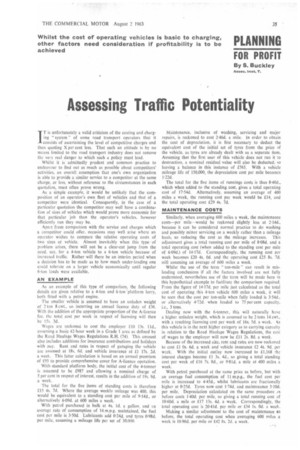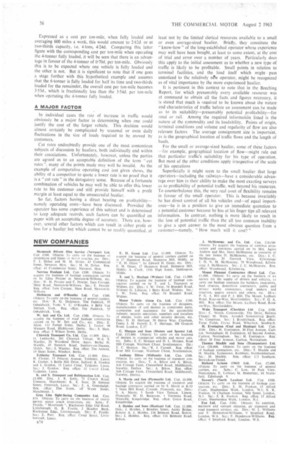Assessing Traffic Potentiality
Page 57

Page 58

If you've noticed an error in this article please click here to report it so we can fix it.
IT is unfortunately a valid criticism of the costing and charging " system" of some road transport operators that it consists of ascertaining the level of competitive charges and then quoting X per cent less. That such an attitude is by no means limited to the road transport industry does not remove the very real danger to which such a policy must lead.
Whilst it is admittedly prudent and common practice to endeavour to find out as mud] as possible about competitors' activities, an overall assumption that one's own organization is able to provide a similar service to a competitor at the same charge, or less, without reference to the circumstances in each quotation, must often prove wrong.
As a simple example, it would be unlikely that the composition of an operator's own fleet of vehicles and that of a competitor were identical. Consequently, in the case of a particular quotation the competitor may well have a combination of sizes of vehicles which would prove more economic for that particular job than the operator's vehicles, however efficiently run they may be.
Apart from comparison with the service and charges which a competitor could offer. occasions may well arise where an operator wishes to compare the relative operating costs of two sizes ot vehicle. Almost inevitably when this type of problem arises, there will not be a clear-cut jump from the need, say, for a 4-ton vehicle to a 6-ton vehicle because of increased traffic. Rather will there be an. interim period when a decision has to be made as to how much under-loading one could tolerate on a larger vehicle economically until regular 6-ton loads were available.
AN EXAMPLE As an example of this type of comparison, the following details are given relative to a 4-ton and 6-ton 'platform lorry, both fitted with a petrol engine.
The smaller vehicle is assumed to have an unladen weight of 2 ton 8 cwt., so incurring an annual licence duty of £36. With the addition of the appropriate proportion of the A-licence fee, the total cost per week in respect of licensing will then he 15s. 3d..
Wages are reckoned to cost the employer £10 13s. 11d., assuming a basic 42-hour week in a Grade I area as defined by the Road Haulage Wages Regulations R.H. (74). This amount also includes additions for insurance contributions and holidays with pay. Rent and rates in respect of garaging the vehicle are assessed at 18s. 6d. and vehicle insurance at £1 17s. 2d. a week. This latter calculation is based on an annual premium of £93 to provide comprehensive cover for A-licence operation.
With standard platform body, the initial cost of the 4-tonner is assumed to be £987 and allowing a nominal charge of 5 per cent in respect of interest, results in the addition of 19s. 9d. a week.
The total for the five items of standing costs is therefore £15 4s. 7d. Where the average weekly mileage was 400, this would be equivalent to a standing cost per mile of 9-14d., or alternatively 6-09d. at 600 miles a week.
With petrol purchased in bulk at 4s, Id. a gallon, and an average rate of consumption of 14 m.p.g. maintained, the fuel cost per mile is 3-50d. Lubricants add 0.24d. and tyres 0-98d. per mile, assuming a mileage life per set of 30.000.
Maintenance, inclusive of washing, servicing and major repairs, is reckoned to cost 2-46d. a mile. In order to obtain the cost of depreciation, it is first necessary to deduct the equivalent cost of the initial set of tyres from the price of the vehicle, as tyres are already dealt with as a separate item. Assuming that the first user of this vehicle does not run it to destruction, a nominal residual value will also be deducted, so leaving a balance in this instance of £765, With a vehicle mileage life of 150,000, the depreciation cost per mile becomes 1.22d.
The total for the five items of runnings costs is thus 8.40d, which when added to the standing cost, gives a total operating cost of I7.54d. Alternatively, assuming an average of 400 miles a week, the running cost per week would be £14, and the total operating cost £29 4s. 7d.
MAINTENANCE COSTS
Similarly, when averaging 600 miles a week, the maintenance costs-per mile-would be reckoned slightly less at 2-14d., because it can be considered normal practice to do washing and possibly minor servicing on a weekly rather than a mileage basis, so reducing the cost as the mileage increases. This adjustment gives a total running cost per mile of 8-08d, and a total operating cost (when added to the standing cost per mile of 6.09d.) of 14.17d. Correspondingly, the running cost uer week becomes £20 4s. Od. and the operating cost £25 8s. 7d, still assuming an average of 600 miles a week,
Whilst the use of the term " ton-mile" can result in misleading conclusions if all the factors involved are not fully understood, nevertheless use of the term will be made here in this hypothetical example to facilitate the comparison required. From the figure of 14.17d. per mile just calculated as the total cost of operating this 4-ton vehicle 600 miles a week, it will be seen that the cost per ton-mile when fully loaded is 3.54d., or alternatively 4-72d. when loaded to 75 per cent capacity, i.e., 3 tons.
Dealing now with the 6-tormer, this will naturally have a higher unladen weight, which is assumed to be 2 tons 14 cwt., with a resulting licensing cost per week of 16s. 5d. a week. iks this vehicle is in the next higher category as to carrying capacity in relation to the Road Haulage Wages Regulations, the cost of wages to the employer will now be £11 2s. 8d, a week.
Because of the increased size, rent and rates are now reckoned to cost £1 Os. 6d. a week and vehicle insurance £2 4s. 9d, per week. With the initial outlay now increased to £1,168 the interest charges become El 3s. 4d., so giving a total standing cost per week of £16 7s. 8d., or 9.81d. a mile at 400 miles a week.
With petrol purchased at the same price as before, but with an average fuel consumption of 11 m.p.g., the fuel cost per mile is increased to 4-45d., whilst lubricants are fractionally higher at 0-25d. Tyres now cost 1-74d. and maintenance 3-10d. per mile. Depreciation calculated on the same procedure es before costs I-40d, per mile, so giving a total running cost of 10-60d. a mile or £17 13s. 4d, a week. Correspondingly, the total operating cost is 20-4Id. per mile or 134 Is. Od. a week.
Making a similar adjustment to the cost of maintenance as before, the total operating cost when averaging 600 miles a week is 16-96d. per mile or £42 8s. 2d. a week. Expressed as a cost per ton-mile, when fully loaded and averaging 600 miles a week, this would amount to 2-82d. or at two-thirds capacity, i.e. 4 tons, 4-24d. Comparing this latter figure with the corresponding cost per ton-mile when operating the 4-tonner fully loaded, it will be seen that there is an advantage in favour of the 4-tonner of 0.70d. per ton-mile. Obviously this is to be expected where one vehicle is fully loaded and the other is not. But it is significant to note that if one goes a stage further with this hypothetical example and assumes that the 6-tonner is fully loaded for half its time and two-thirds loaded for the remainder, the overall cost per ton-mile becomes 3.53d., which is fractionally less than the 3.54d. per ton-mile when opuating the 4-tonner fully loaded.
A MAJOR FACTOR
In individual cases the rate of increase in traffic would obviously be a major factor in determining when one could justify the cost of the larger vehicle. This decision would almost certainly be complicated by seasonal or even daily fluctuations in the size of loads required to be .moved by customers.
Cut rates undoubtedly provide one of the most contentious subjects of discussion by hauliers, both individually and within their associations. Unfortunately, however, unless the parties are agreed as to an acceptable definition of the term "cut rates ''. many of the points made may well be invalid. As the example of comparative operating cost just given shows, the ability of a competitor to quote a lower rate is no proof that it is a "cut rate" in the derogatory sense. Because of a fortunate combination of vehicles he may well be able to offer this lower rate to his customer and still provide himself with a profit margin at least equal to the unsuccessful haulier.
So far, factors having a direct bearing on profitability— namely operating costs—have been discussed. Provided the operator has some experience of this subject and is determined to keep adequate records, such factors can he quantified on paper with an acceptable degree of accuracy. There are, however, several other factors which can result in either profit or loss for a haulier.but which cannot be so readily quantified. at
least not by the limited clerical resources available to a small or even average-sized haulier. Briefly, they constitute the " know-how" of the long-established operator whose experience may well have been bought, at least to some extent, at the cost of trial and error over a number of years. Particularly does this apply to the initial assessment as to whether a new type of traffic is likely to be profitable. Small points in relation to terminal facilities, and the load itself which might pass unnoticed to the relatively OW operator, might be recognized as of vital importance by the more experienced haulier.
It is pertinent in this context to note that in the Beeching Report, for which presumably every available resource was at command to obtain all the facts and figures necessary, it is stated that much is required to be known about the nature and characteristics of traffic before an assessment can.be made as to its suitability—presumably potential profitability—for road or rail. Among the required information listed is the nature of the commodity and its loadability. Points of origin, terminal conditions and volume and regularity of flow are also relevant factors The average consignment size is important. as is ,the geographical location of traffic flows and the length of hauls.
For the small or average-sized haulier, some of these factors ---for example, geographical location of flow—might rule out that particular traffic's suitability for his type of operation. But most of the other conditions apply irrespective of thescale of his operations
Superficially it might seem to the small haulier that large operators—including the railways—have a considerable advantage over him in their ability to make the most exacting surveys as to profitability of potential traffic, well beyond his resources. To counterbalance this, the very real asset of flexibility remains in favour of the small operator. This is because invariably he has direct control of all his vehicles and—of equal importance—he is in a position to give an immediate quotation to a potential customer because he has at his finger tips all relevant information. In contrast. nothing is more likely to result in the loss of potential traffic than the all too common inability to give a spot answer to the most obvious question from a customer—namely, " How much will it cost?"




























































































